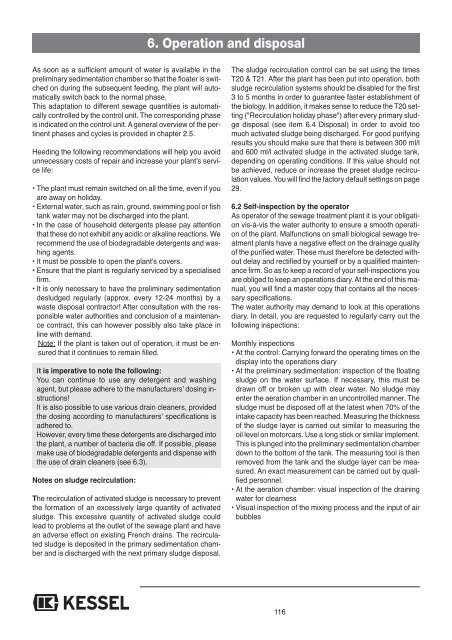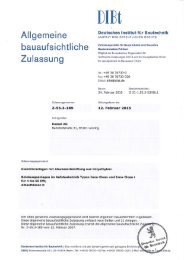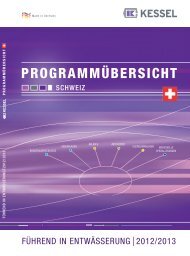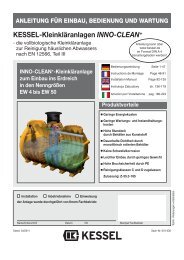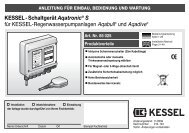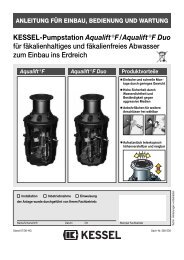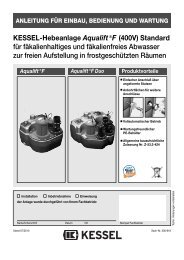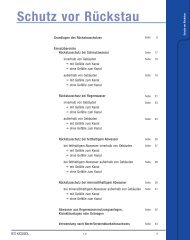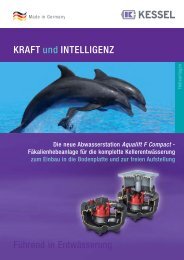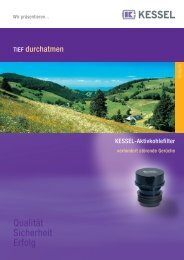KESSEL-Kleinkläranlagen InnoClean PLUS
KESSEL-Kleinkläranlagen InnoClean PLUS
KESSEL-Kleinkläranlagen InnoClean PLUS
You also want an ePaper? Increase the reach of your titles
YUMPU automatically turns print PDFs into web optimized ePapers that Google loves.
As soon as a sufficient amount of water is available in the<br />
preliminary sedimentation chamber so that the floater is switched<br />
on during the subsequent feeding, the plant will automatically<br />
switch back to the normal phase.<br />
This adaptation to different sewage quantities is automatically<br />
controlled by the control unit. The corresponding phase<br />
is indicated on the control unit. A general overview of the pertinent<br />
phases and cycles is provided in chapter 2.5.<br />
Heeding the following recommendations will help you avoid<br />
unnecessary costs of repair and increase your plant's service<br />
life:<br />
• The plant must remain switched on all the time, even if you<br />
are away on holiday.<br />
• External water, such as rain, ground, swimming pool or fish<br />
tank water may not be discharged into the plant.<br />
• In the case of household detergents please pay attention<br />
that these do not exhibit any acidic or alkaline reactions. We<br />
recommend the use of biodegradable detergents and washing<br />
agents.<br />
• It must be possible to open the plant's covers.<br />
• Ensure that the plant is regularly serviced by a specialised<br />
firm.<br />
• It is only necessary to have the preliminary sedimentation<br />
desludged regularly (approx. every 12-24 months) by a<br />
waste disposal contractor! After consultation with the responsible<br />
water authorities and conclusion of a maintenance<br />
contract, this can however possibly also take place in<br />
line with demand.<br />
Note: If the plant is taken out of operation, it must be ensured<br />
that it continues to remain filled.<br />
It is imperative to note the following:<br />
You can continue to use any detergent and washing<br />
agent, but please adhere to the manufacturers' dosing instructions!<br />
It is also possible to use various drain cleaners, provided<br />
the dosing according to manufacturers' specifications is<br />
adhered to.<br />
However, every time these detergents are discharged into<br />
the plant, a number of bacteria die off. If possible, please<br />
make use of biodegradable detergents and dispense with<br />
the use of drain cleaners (see 6.3).<br />
Notes on sludge recirculation:<br />
The recirculation of activated sludge is necessary to prevent<br />
the formation of an excessively large quantity of activated<br />
sludge. This excessive quantity of activated sludge could<br />
lead to problems at the outlet of the sewage plant and have<br />
an adverse effect on existing French drains. The recirculated<br />
sludge is deposited in the primary sedimentation chamber<br />
and is discharged with the next primary sludge disposal.<br />
6. Operation and disposal<br />
The sludge recirculation control can be set using the times<br />
T20 & T21. After the plant has been put into operation, both<br />
sludge recirculation systems should be disabled for the first<br />
3 to 5 months in order to guarantee faster establishment of<br />
the biology. In addition, it makes sense to reduce the T20 setting<br />
("Recirculation holiday phase") after every primary sludge<br />
disposal (see item 6.4 Disposal) in order to avoid too<br />
much activated sludge being discharged. For good purifying<br />
results you should make sure that there is between 300 ml/l<br />
and 600 ml/l activated sludge in the activated sludge tank,<br />
depending on operating conditions. If this value should not<br />
be achieved, reduce or increase the preset sludge recirculation<br />
values. You will find the factory default settings on page<br />
29.<br />
6.2 Self-inspection by the operator<br />
As operator of the sewage treatment plant it is your obligation<br />
vis-à-vis the water authority to ensure a smooth operation<br />
of the plant. Malfunctions on small biological sewage treatment<br />
plants have a negative effect on the drainage quality<br />
of the purified water. These must therefore be detected without<br />
delay and rectified by yourself or by a qualified maintenance<br />
firm. So as to keep a record of your self-inspections you<br />
are obliged to keep an operations diary. At the end of this manual,<br />
you will find a master copy that contains all the necessary<br />
specifications.<br />
The water authority may demand to look at this operations<br />
diary. In detail, you are requested to regularly carry out the<br />
following inspections:<br />
Monthly inspections<br />
• At the control: Carrying forward the operating times on the<br />
display into the operations diary<br />
• At the preliminary sedimentation: inspection of the floating<br />
sludge on the water surface. If necessary, this must be<br />
drawn off or broken up with clear water. No sludge may<br />
enter the aeration chamber in an uncontrolled manner. The<br />
sludge must be disposed off at the latest when 70% of the<br />
intake capacity has been reached. Measuring the thickness<br />
of the sludge layer is carried out similar to measuring the<br />
oil level on motorcars. Use a long stick or similar implement.<br />
This is plunged into the preliminary sedimentation chamber<br />
down to the bottom of the tank. The measuring tool is then<br />
removed from the tank and the sludge layer can be measured.<br />
An exact measurement can be carried out by qualified<br />
personnel.<br />
• At the aeration chamber: visual inspection of the draining<br />
water for clearness<br />
• Visual inspection of the mixing process and the input of air<br />
bubbles<br />
116


